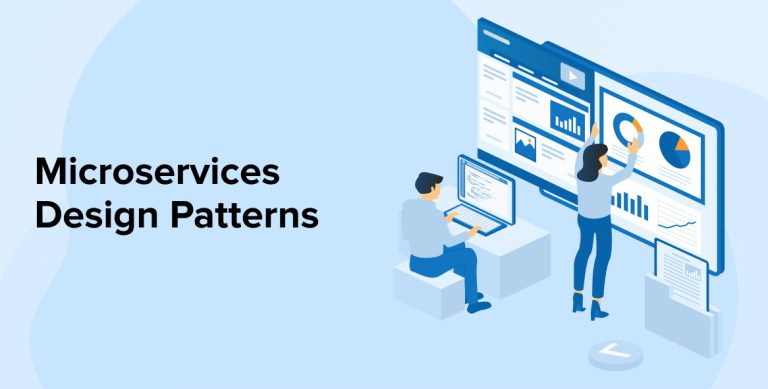
Today’s digitally growing market is increasing the demand for software applications in every business. Organizations are now requesting unique and user-friendly applications at a faster pace from custom software development companies. And to fulfill the client’s demands and business requirements, software engineers have started using Microservices, a service-oriented architectural style.
Microservices have emerged and become a go-to method for creating applications as most businesses prefer their applications created using microservices architecture pattern rather than a monolithic design. And this is why all software engineers must have a proper understanding of Microservice Architecture and the design patterns that come with it. This is why, in this blog, we are going to have a look at what microservices are and the microservices design patterns.
1. What are Microservices?
Microservices are known as the architectural and organizational approach that can be used by the developers to make the software development process easy and understandable. Every software development company that utilizes microservices architecture can independently operate small autonomous services through APIs, allowing them to communicate with each other. Small developed teams manage these services, contributing to a speedier development process and ultimately leading to greater development and faster marketing time for applications.
Basically, microservices are an architecture-based framework that helps in developing applications. When software engineers use it, the framework for development connects and distributes, ensuring that changes made by one team do not affect the entire application development process. This is the biggest advantage of microservices. Besides, it enables the developers to quickly create new parts and functions of applications to address changing requirements of businesses.
📌 What are Microservices?
— Rapid (@Rapid_API) April 13, 2023
Microservices are a software architecture pattern in which an application is broken down into small, independent services that can be developed, deployed, and scaled independently.
One of the biggest advantages of microservices is their flexibility.
2. Principles Used for Microservices Design Patterns for Architecture
Here are some of the major principles that are used to design Microservices –
- Auto -Provisioning
- Scalability
- Resilient Services
- Decentralization
- Independent & Autonomous Services
- Availability
- Real-Time Load Balancing
- Seamless API Integration and Continuous Monitoring
- Isolation from Failures
3. Top Microservices Design Patterns
Here are some of the top design patterns for microservices that used by software development companies –
3.1 Saga
SAGA is known as one of the widely used solutions when it comes to keeping consistency in the distributed architecture with data and without any interruption of principle usages like ACID. Saga is a microservice design pattern that is responsible for carrying out various commentary transactions by offering rollback possibilities. To achieve Saga, there are two ways that can be carried out by the development companies and they are –
Choreography
Choreography is an approach within the Saga where there is no central orchestration. This means that each service carried out in Saga has its own transactions and publishing events. And other services respond to those occurrences and perform their own tasks. Besides this, as per the scenario, the Saga services may publish additional events.
Orchestration
Orchestration saga is a process where each service that participates in Saga performs its own events and transactions. But the other services offer their response to those services in order to complete the tasks.
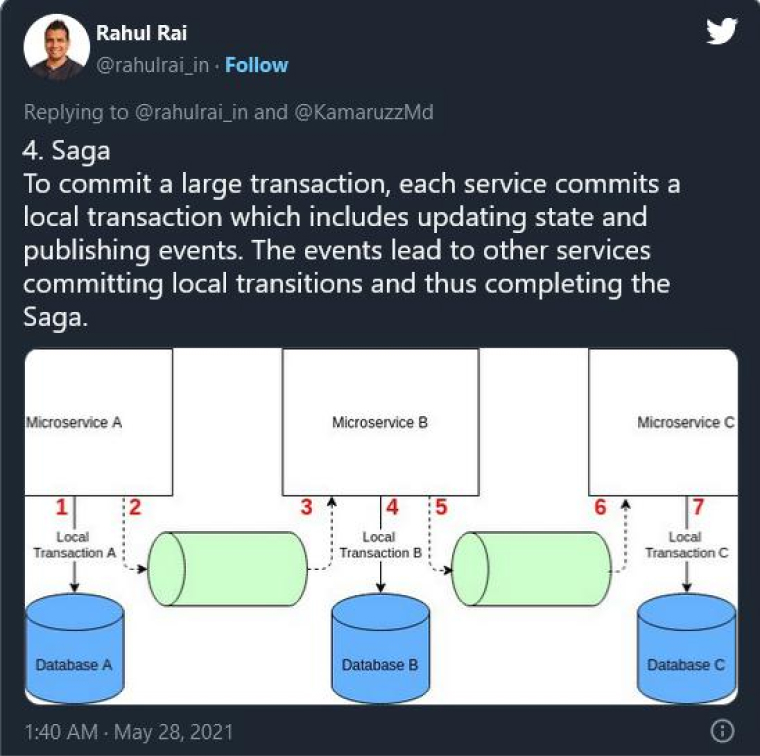
Advantages of Saga
- This event-driven microservices architecture offers a highly scalable or loosely linked consistency with the use of transactions.
- Using NoSQL databases without 2PC support is possible to offer surface-through transactions.
3.2 Aggregator Pattern
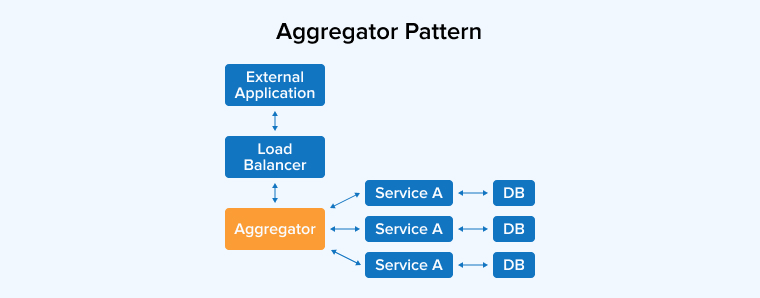
Another top microservices design pattern is Aggregator. It refers to a website or a program that has the capability to retrieve data and display them. This means that in the world of microservices pattern, Aggregator is known as the basic web page that is used by the software developers to invoke multiple different services to get the necessary functionalities of the website or information for the users. Besides this, since the output source in this microservice architecture gets divided by breaking the monolithic architecture into multiple microservices, this is very beneficial for getting output that is combined with data from other multiple services.
Basically, Aggregator is one of the design patterns that offer unique transaction ID to the services which means that when there are two services and each has its own database, this design pattern will collect the data from each microservices architecture and apply logic to it before publishing it as a REST endpoint. Besides this, Aggregator is a pattern that is based on the DRY principle which means that it enables the developers to abstract the logic into composite or consumer service and business logic into one service instance.
Advantages of Aggregator Pattern
- Aggregator pattern offers internal services with flexibility.
- Tunneling microservices on x- and z-axes is possible in a more scalable manner.
- Microservices functionalities can be offered with a single point of access.
3.3 API Gateway Design Pattern
API Gateway pattern is a type of microservices that is built in a way that enables each service to have its own functionality. But, sometimes when in this type of architecture the application breaks down into smaller autonomous services, problems might arise for the developers and these problems can be as follows – how to handle multiple protocol requests? how to request information from various services? and more.
/3 🔹API Gateway: This handles incoming requests and routes them to the relevant services. It talks to the identity provider and service discovery.
— Alex Xu (@alexxubyte) August 31, 2022
🔹Identity Provider: This handles authentication and authorization for users. pic.twitter.com/LV8b7vRnQy
An API gateway design pattern can solve all these problems. This microservice functions as a proxy service, routing a request to the relevant microservice and addressing the aforementioned issues. The API gateway pattern, a variation of the Aggregator pattern, allows the API gateway to send requests to multiple microservices and retrieve the results for the consumer service or composite, similar to an aggregator. Additionally, the API Gateway pattern serves as an entry point for all microservices, facilitating the creation of finely grained APIs for different clients.
Basically, API microservice is very beneficial to any software development company. It also enables the conversion of protocol requests and enables offloading of the authorization responsibilities of the microservice. When using the API gateway method, anyone can enable their website’s client side to send a request, and the API Gateway will then act as an entry point to forward the client’s suggestion to the suitable microservice. After that, the load balancer in the system helps to load the request and send it to the respective services. To find out the route of this request and its communication, the microservice uses Service Discovery and then the services will start communicating with each other through the stateless server.
Advantages of API Gateway Design Pattern
- With an API gateway pattern, loosely coupling microservices for the front end and back end is possible.
- It offers SSL authentication, termination, and authorization for high security.
- Throttling, logging & monitoring, and load balancing are centrally managed.
3.4 Strangler Pattern
Strangler is another popular microservices design patterns used by software development companies. This pattern was originally introduced in 2004 by Martin Fowler with the “StranglerFigApplication” blog post. Developers use this pattern when migrating their client’s current application to the microservices approach becomes challenging, and they find maintaining the application’s availability difficult. The strangler pattern is known for its ability to make this migration easy and efficient.
When the developer decides to migrate the existing application to microservices, they can use the strangler pattern to enable a reliable and incremental process of refactoring the source code.This approach describes a method that enables businesses to move specific functionalities of the application one by one with a new microservice. Besides this, one of the main reasons behind software engineers choosing this pattern is that in this approach the changes are incremental, well-defined, monitored, and the chances of things going south are less.
When software developers prioritize application availability as one of the business’s top-most priorities, they choose the Strangler pattern. This approach also ensures the creation of a system with better test coverage. Besides this, when the time for migration arises, an API gateway microservices design pattern acts as a front that directs all the users’ requests to the correct application. Having such pretense enables the user’s requests to know that such an application exists. Besides this, it also enables the application development teams to migrate the system at their own pace without any external issues. After completing the migration, we retire the monolithic app.
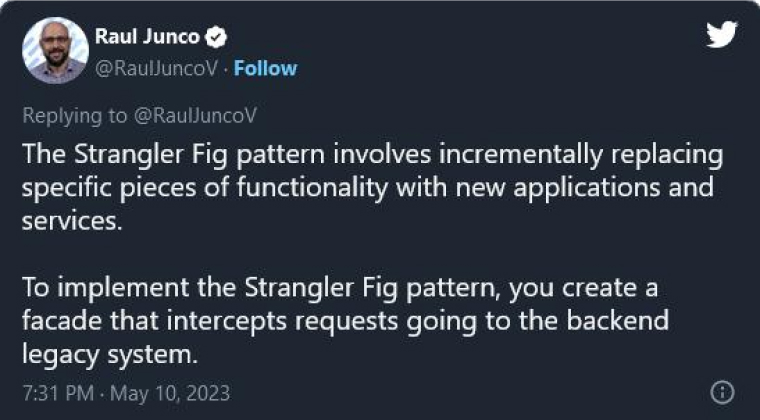
Advantages of Strangler Pattern
- The strangler pattern enables the migration process with speed.
- It enables safe conversion from monolithic applications to microservices.
- You can simultaneously carry out the migration process and development.
3.5 Event Sourcing Design Pattern
Event Sourcing Design Pattern is a type of microservices pattern that is in charge of creating a new, sequential sequence of application events. By querying the data, one can recreate the application state using this method. But when the development team decides to do so, they have to reimagine all the changes they have made in the program’s condition to do so.
Using the event sourcing method has the main aim of enabling the system to capture any changes made in the form of an entity. Essentially, in the system of any business organization, this approach adds a new event every time the state of an object changes, establishing the sequence of events. This approach makes the operation virtually atomic, implying that the current state of an entity can be reconstructed by replaying its occurrences.
Advantages of Event Sourcing Design Pattern
- Event sourcing design pattern offers extremely scalable systems atomicity.
- This microservices pattern enables a loosely connected and event-driven approach.
- It also enables keeping entity history automatically.
3.6 Command Query Responsibility Segregation (CQRS)
The development teams use the CQRS microservice design pattern to run complicated queries that cover many service databases. They choose this pattern because it allows them to confine data access to a single database, leading to the usage of the command query responsibility segregation service. With the help of this microservice, the developers will be able to break the program into two sections namely query and command. The command section of the microservice will handle all requests for creating and updating entries in the database, while the query section will materialize views.
Basically, the command component in the command query responsibility segregation microservice design pattern implies that it will be in charge of creating, deleting, and updating the statements of the application while on the other hand, the query section will be reading all the statements.
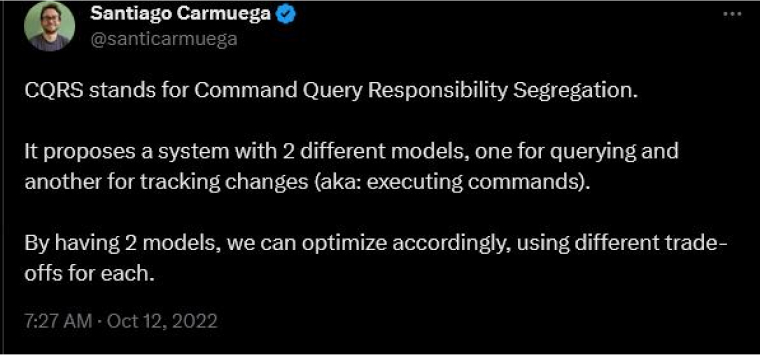
Advantages of Command Query Responsibility Segregation
- CQRS enables the availability of data with better speed.
- With this pattern, data reading in event-driven Microservices is possible at a faster level.
- It enables developers to scale both read and write systems independently.
3.7 Decomposition Patterns
App development companies commonly utilize decomposition as one of the most popular microservices patterns. Typically, developers create services to facilitate the creation of smaller units, each with its own functionalities. However, when a developer chooses to break down an application into smaller units, they must logically carry out the process. This is why developers use decomposition patterns to assist in breaking an application into small services.
Decomposition is a design pattern that can help the developers to either decompose an application based on the capabilities of the business or the sub-domains. For instance, if the developers are working for an ecommerce application, they can separate services for payment, products, orders, and customers if they wish to decompose the application by business capabilities. If they want to decompose the application by sub-domains, they need to create smaller services for each class. For example, they can consider the customer as a class, and then use this class in customer support or customer management. This implies that you can achieve decomposition using this microservice pattern by employing domain-driven design, which allows dividing the entire domain model of an application into sub-domains. And after the division, each sub-domains can have its own scope or model.
Decomposition pattern is very feasible when it comes to smaller applications but when the developer wants to use this pattern for big monolithic applications, it can be a bit difficult as in this pattern, identifying the business capabilities or sub-domains for an application can be a huge task when the size of the business and application is big. Therefore in such cases, the developers can use the Strangler pattern to decompose big monolithic applications.
Advantages of Decomposition Patterns
- Decomposition pattern enables cohesive and loosely coupled approaches.
- It allows developers to decompose applications based on business capabilities or sub-domains of the applications.
- Both business capabilities and sub-domains are relatively stable with this architecture.
4. Conclusion
As seen in this blog, Microservices are critical but very beneficial to software development companies as they help them create applications smoothly and achieve their goals. Regardless of the application’s size or client’s requirements, microservices architecture can be useful for developing unique, robust, and user-friendly applications with faster development time and lesser costs. And when developers are working for businesses who want to convert their monolithic applications using microservices architecture, though it could take more effort and resources, the rewards are well worth it. But this can only happen when the developers have proper knowledge of the essential microservice design patterns and know which pattern can be more useful for a specific type of business application.
Therefore, having an understanding of the above listed and more such upcoming patterns is a must to specialize in the design requirements of microservices.



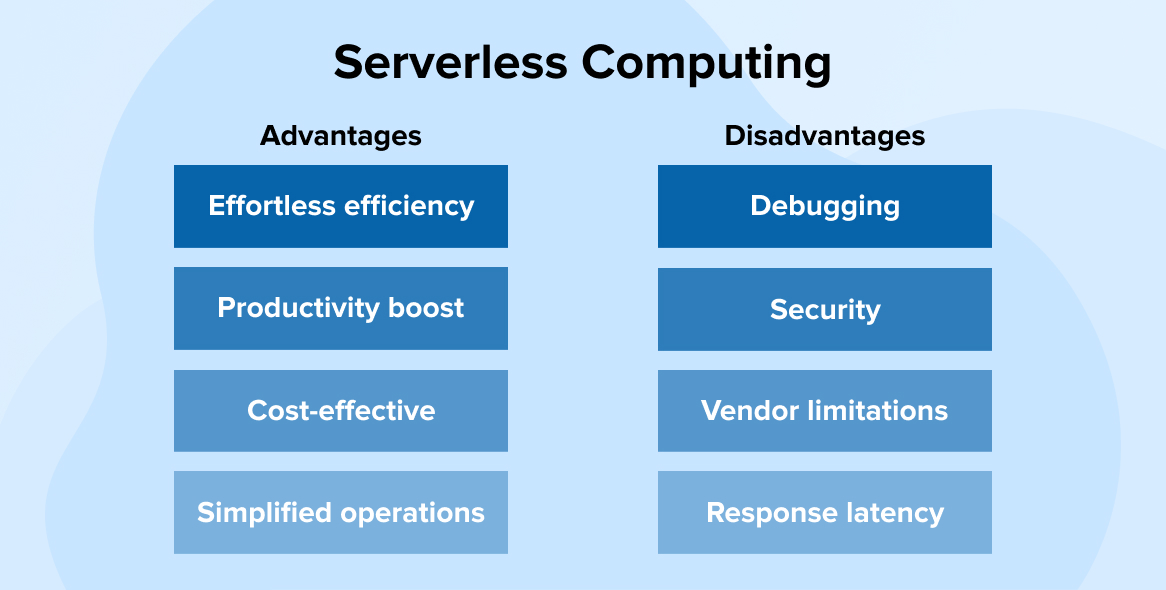
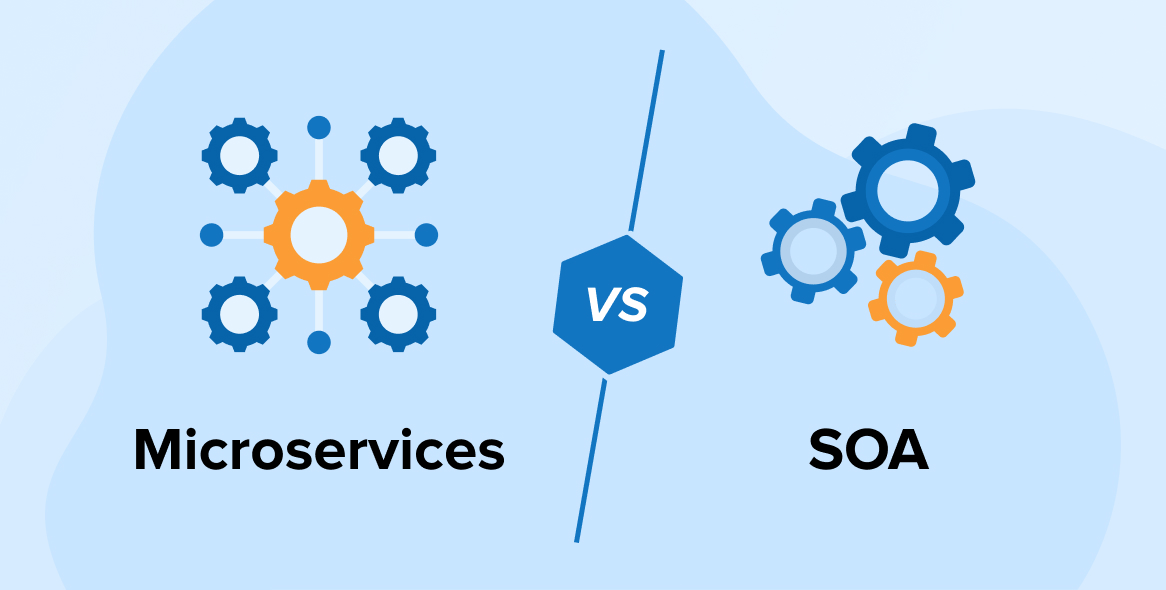

Article provides a comprehensive overview of the role of microservices design patterns in modern software development. The breakdown of various design patterns, provides a clear insight into how software developers can harness the benefits of microservices.
This blog offers insights into the microservices design patterns. It makes it easier for developers to understand & leverage these patterns effectively.